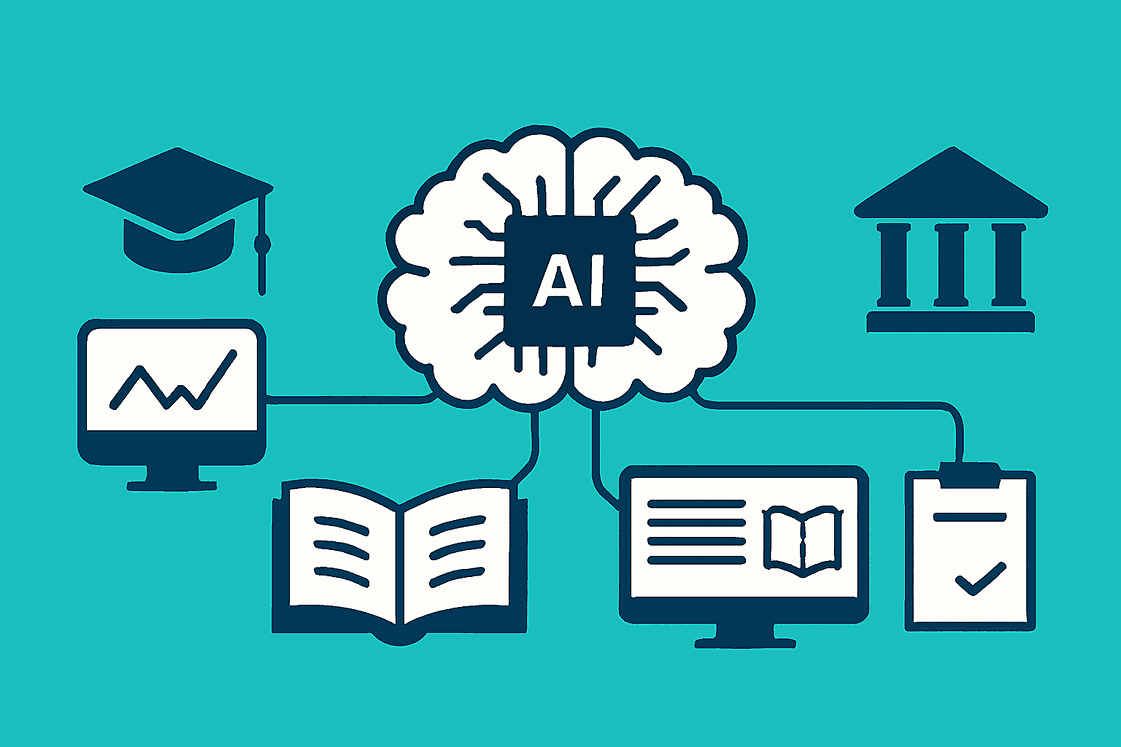Introduction
AI in Education Document Management is rapidly becoming the backbone of modern classrooms, campuses, and online learning platforms. Education has always relied on the exchange of information—lesson plans, student records, assessments, accreditation files, and more. Every institution depends on the smooth flow of these documents to deliver quality education, ensure compliance, and support student success.
Yet, despite the digital age, many schools and universities remain weighed down by outdated, manual processes. From grading and admissions to compliance reporting and curriculum updates, educators and administrators often find themselves buried in paperwork. The result? Delays, errors, and missed opportunities to focus on what truly matters: teaching and learning.
Artificial Intelligence is changing this reality. By embedding AI in Education Document Management, institutions are automating workflows, enhancing data accuracy, and building smarter, more resilient systems that strengthen both operational excellence and student outcomes.

Understanding Document Lifecycle Management in Education
At the heart of every educational institution lies a complex web of documentation. A student’s transcript, a teacher’s lesson plan, or a university’s accreditation file may seem like isolated records, but together they form the backbone of academic decision-making and institutional accountability.
Key Stages of the Document Lifecycle
- Creation Documents originate from multiple sources: student enrollment forms, assignment templates, faculty evaluations, financial aid applications, and more. While many institutions have adopted digital tools, paper-based records remain common, particularly in legacy systems or regions where digital infrastructure is still developing.
- Capture This stage involves digitizing physical documents and importing data from emails, learning management systems (LMS), or scanned forms. Technologies such as Optical Character Recognition (OCR) convert these into searchable formats, making them easier to store and retrieve.
- Storage Secure storage is essential. Whether on-premises or in the cloud, institutions must ensure that sensitive student data is encrypted, access-controlled, and compliant with privacy regulations.
- Usage Teachers, administrators, and support staff access documents for grading, reporting, curriculum planning, and student advising. Real-time access reduces errors, improves collaboration across departments, and ensures that decisions are based on accurate, up-to-date information.
- Archiving and Disposal Records are retained based on legal and institutional policies before being archived or securely deleted. Automated retention policies help institutions comply with education standards, accreditation requirements, and privacy laws.
“Document management is the backbone of educational integrity. When done right, it empowers institutions to operate efficiently and ethically.”
Why Document Management Matters
Effective AI in Education Document Management is not just about organization—it is about trust. Students and parents rely on institutions to protect personal data, maintain accurate records, and deliver timely services. Regulatory bodies expect transparency and accountability. Educators need reliable systems that allow them to focus on teaching rather than administrative tasks.
When documentation is mismanaged, the consequences can be severe: delayed admissions, inaccurate transcripts, missed accreditation deadlines, or even breaches of sensitive student data. Conversely, when documentation is managed well, institutions build credibility, strengthen relationships with stakeholders, and create an environment where learning can flourish.
Common Pain Points in Education Workflows
Institutions without AI in Education Document Management often face:
- Manual grading and reporting delays
- Enrollment and records management errors
- Accreditation and compliance risks
- Data privacy and security vulnerabilities
How AI Is Transforming Document Management in Education
By applying AI in Education Document Management, schools and universities can:
- Automate document ingestion and classification
- Extract and integrate data seamlessly with SIS and LMS platforms
- Reduce manual errors and accelerate reporting
- Ensure compliance with audit-ready documentation
AI-Powered Document Ingestion and Classification
Educational institutions receive documents from multiple sources—emails, scanned forms, LMS exports, and more. AI tools can capture documents from these channels, use OCR and Natural Language Processing (NLP) to convert unstructured data into machine-readable formats, automatically classify documents (such as assignments, transcripts, or financial aid forms), and route them to the correct department or student profile.
Automated Data Extraction and Integration
AI can extract key data points from handwritten notes, scanned forms, and narrative feedback. This includes grades, attendance records, learning outcomes, student demographics, and accreditation metrics. Standard formats such as JSON, IMS Global standards, and LTI protocols ensure seamless integration with Student Information Systems (SIS) and LMS platforms.
Key Use Cases in Education Workflow Automation
- Admissions Processing AI analyzes applications, extracts key data, and checks eligibility criteria. This reduces manual review time, improves enrollment speed, and ensures that students receive timely responses.
- Gradebook Automation Assignments can be scanned and graded using AI models, with results instantly updated in the SIS. Teachers save time, reduce grading inconsistencies, and provide faster feedback to students.
- Accreditation Document Management AI organizes and validates documentation required for accreditation, ensuring timely submission and compliance with standards. This reduces the stress of audits and improves institutional credibility.
- Financial Aid and Scholarship Processing AI tools verify documentation, calculate eligibility, and generate award letters. This streamlines the financial aid process, reduces errors, and improves the student experience.
“AI-powered automation has helped our school process applications in days instead of weeks.” — Admissions Director
Enhancing Compliance and Data Security
With AI in Education Document Management, institutions gain:
- Real-Time Documentation Review: NLP engines prompt educators to clarify vague feedback or fill in missing assessment criteria.
- Automated Audit Trails: Every document interaction is logged securely, simplifying reporting and inspections.
- Data Security: AI tools detect unauthorized access attempts and apply encryption protocols automatically.
“AI doesn’t just speed up tasks—it embeds compliance and security into every step of the documentation process.”
Supporting Remote Learning and Collaboration
The rise of remote and hybrid learning has made documentation even more critical. AI in Education Document Management enables real-time data collection from learning apps, virtual classrooms, and home-based assessments. It also supports collaboration among teachers, students, and administrators by providing secure sharing, version control for curriculum updates, and digital consent for parental approvals.
These features foster transparency, improve engagement, and ensure that learning continues seamlessly regardless of location.
Improving Student Engagement Through AI-Driven Documentation
AI transcription tools capture classroom interactions and convert them into structured digital records. This ensures that critical information is not lost and that documentation is available immediately after sessions. Teachers can focus more on students rather than note-taking.
AI can also generate Subjective, Objective, Assessment, and Plan (SOAP) notes from teacher observations or student interactions. This creates consistent documentation formats, reduces manual entry errors, and enhances collaboration between educators.
Optimizing Educational Funding and Resource Allocation
AI helps institutions manage financial documentation and funding workflows more effectively.
- Funding Application Automation: Extracts and validates data for grants and scholarships.
- Appeal Letter Generation: Drafts responses to denied funding requests.
- Predictive Analytics: Identifies underutilized resources and guides budget decisions.
Reliable automation builds trust with students, parents, and funding bodies by ensuring that resources are allocated fairly and transparently.
Cross-Industry Insights: Lessons from Other Sectors
The transformation in education mirrors innovations in other sectors. For example, a retail brand improved customer experience by integrating its online and offline stores through a unified point-of-sale system—similar to how schools are unifying digital and physical learning environments. A SaaS company scaled its platform by analyzing its Total Addressable Market and adopting modular product design—an approach that edtech startups can emulate to expand their reach.
These parallels highlight the universal value of intelligent workflows and demonstrate that education can learn from the successes of other industries.
Conclusion: Building the Future of Education with AI
By embedding AI in Education Document Management into every stage of the document lifecycle—from ingestion to compliance—educational institutions are building intelligent workflows that support student success, operational efficiency, and long-term sustainability.
The future of education is not simply digital. It is intelligent, secure, and deeply human-centered. Institutions that embrace AI-driven document management are not just adopting new tools; they are reimagining the very foundation of how education is delivered, measured, and experienced.
Education has always been about more than information. It is about shaping lives, building communities, and preparing future generations to thrive. Documentation may seem like a mundane aspect of this mission, but it is, in fact, the backbone of educational integrity. When documentation is accurate, secure, and accessible, it empowers educators to teach, students to learn, and institutions to grow.
Artificial Intelligence is not a silver bullet, but it is a powerful ally. By embedding intelligence into the very fabric of educational workflows, institutions can create systems that are not only efficient but also resilient, ethical, and human-centered.
The future of education will not be defined by paperwork, delays, or inefficiencies. It will be defined by AI in Education Document Management systems that empower institutions to operate with precision, agility, and integrity. These intelligent workflows are not simply about saving time; they are about creating the conditions for deeper learning, stronger compliance, and more meaningful engagement between educators and students.
Looking Ahead
As institutions continue to adopt AI-driven solutions, the emphasis will shift from reactive problem-solving to proactive innovation. Instead of scrambling to meet accreditation deadlines, universities will have compliance-ready documentation at their fingertips. Instead of teachers spending evenings grading, they will have more time to mentor, inspire, and connect with students. Instead of administrators struggling with fragmented systems, they will benefit from unified platforms that provide real-time insights into every aspect of the academic journey.
The next decade will likely see AI in Education Document Management evolve even further, integrating with predictive analytics, blockchain credentialing, and adaptive learning platforms. Together, these technologies will create a holistic ecosystem where documentation is not a burden but a strategic asset.
Final Reflection
Education is, at its core, a human endeavor. It is about curiosity, growth, and the pursuit of knowledge. Yet behind every classroom interaction lies a foundation of records, reports, and compliance requirements that make the system function. By embracing AI in Education Document Management, institutions can ensure that this foundation is strong, secure, and efficient—allowing the true mission of education to shine.
The institutions that act now will not only streamline their operations but also set a standard for excellence in the digital age. They will demonstrate that technology, when applied thoughtfully, can enhance—not replace—the human connections that define education.
At Rannlab Technologies, we believe that the future of education lies in intelligent, secure, and human-centered systems. Our solutions in AI in Education Document Management are designed to help institutions streamline workflows, strengthen compliance, and free educators to focus on what matters most—student success.
If your school, university, or learning platform is ready to reduce administrative burdens, improve data accuracy, and embrace the next generation of educational innovation, we’re here to help. Connect with our team today to explore how we can tailor AI-driven document management solutions to your institution’s unique needs.
Contact us now to start building smarter workflows for a smarter future in education.
In the end, the promise of AI in Education Document Management is not just smarter workflows. It is the creation of an educational environment where every stakeholder—students, teachers, administrators, and regulators—can trust the system, focus on their goals, and thrive.
For further insights, you can explore UNESCO’s official publication AI and Education: Guidance for Policy-Makers, which provides global perspectives on how artificial intelligence can be responsibly integrated into education systems: Read UNESCO’s report here.

